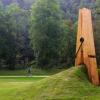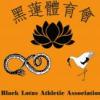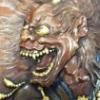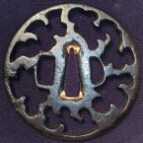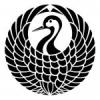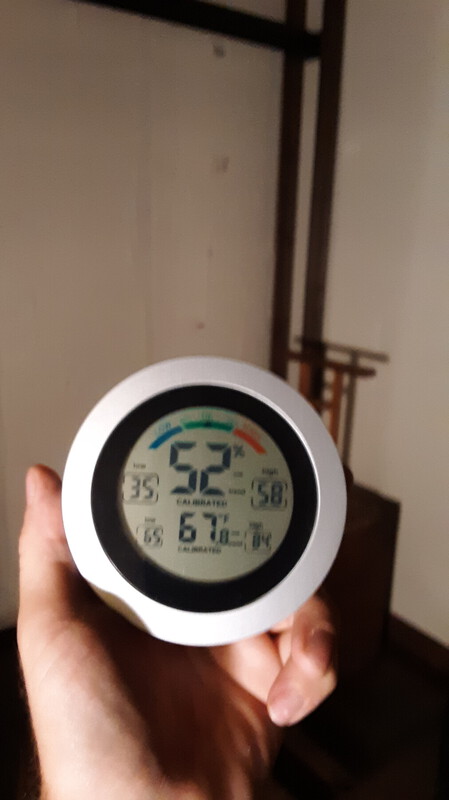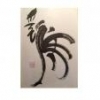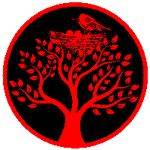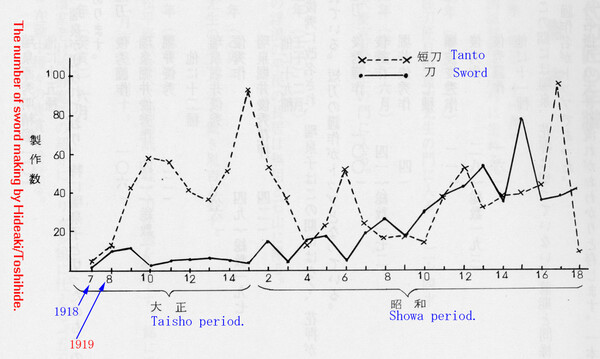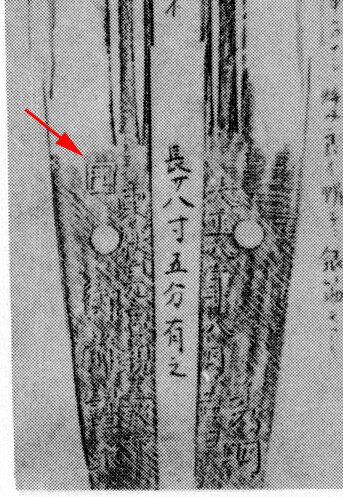Leaderboard
Popular Content
Showing content with the highest reputation on 07/26/2021 in all areas
-
9 points
-
Hi Arnold, You say you want to buy an original sword; if so, you need to buy only from a dealer you can trust 100% or you need to study first (and, shy of getting lucky, those are the only options you have). The fact that you are asking about such an obvious fake tells us you are a beginner. There is nothing wrong with that; we all have been there ourselves, but as a beginner you need either very good advise or a whole lot more knowledge than you currently possess. Otherwise you will run out of money quite quickly. Grey5 points
-
A little addition 1st row: 梨本総裁宮殿下 = Nashimoto sōsai no miya denka (Ref. Prince Nashimoto Morimasa - Wikipedia ) 2nd row: 御檢閲記念 = Goken'etsu kinen (military review's memento)4 points
-
7. With the beams in I decided to start in on the lighting. I used Hampton Bay mini tracks for this project. Here is what it looked like as I was installing: 8. Lights - check! Time to install the J brackets for the sword shelves. Or in this case level: B-A-L-A-N-C-E...balance (Can you guess the movie?). 9. With the brackets in - it was then time to install the beams. I used 2x4x8 stained in Kona.3 points
-
3 points
-
3 points
-
Besides the above references, Guy (AKA ghp95134) over at War Relics Forum (WRF) has a pamphlet from the Japan Steel Works (JSW) that depicts all of the swordsmiths. He even shows an example of a business card which I found rather interesting. It is worthy of a look if you are so inclined. The Emperor’s New Clothes, Post #373 points
-
A couple more Japanese language books for the bibliography. Thanks to @lucidorise, @mecox, and Guy (ghp95134) over at WRF for the additions. Jingū chōkokan nōgyō-kan 神宮徴古館農業館 [Jingū History & Agricultural Museums]. Gendaigatana no hyaku-nen: Fukkō to keishō 現代刀の100年: 復興と継承 [One Hundred Years of Modern Swords: Revival and Succession]. Ise 伊勢: Jingūchōkokan nōgyō-kan 神宮徴古館農業館, 2010. 71 pages. Show Us Your High Class Gunto, Post #466 Horii Tanetsugu 堀井・胤次. Enishi: Katanakaji Horii-ke hyakugojū-nen no rekishi えにし: 刀鍛冶堀井家百五十年の歴史 [Enishi: The 150 Year History of the Horii Family of Swordsmiths]. Muroran 室蘭: Horii Tanetsugu 堀井胤次, 1996. NLF Gunto Discussion, Post #323 points
-
This is a replica sword worth about $80 as decorative, nothing to a collector of Nihonto. So sorry, if you buy it. John2 points
-
Larry, You mentioned that your interest is as a collector also. The gunto is worth collecting (possibly Iaido also), so I think Chris' comment about running away was concerning the price only. These gunto normally run in the $1,400-1,800 price range, so if the seller is willing to come down, and you still like the sword, go for it. But like Chris said, his price is double the market value.2 points
-
昭和十八年 - Showa 18th year (1943) 昭和十八年秋 - Showa 18th year, autumn 武久 - Takehisa2 points
-
2 points
-
You just made my day! This needed to be in the joke of the day forum! Love it!2 points
-
It's for the Sarute with clasped monkey hands, a long standing design on Tachi.2 points
-
To get the ball rolling, there are four rows of kanji characters on the back. The second row is repeated on the front which also has the police emblem at the top and firefighting emblem at the bottom. This is what I have trancribed so far. 1st row: 梨本総裁宮殿下 = Nashimoto sōsai kyūden-ka. 2nd row: 御檢閲記念 = O ken'etsu kinen. 3rd row: 昭和十二年四月十一日 = 1937-04-11. 4th row: 岡山縣 = Okayama-ken. As for what the characters are referring to, I will leave that to someone else. However, I think the reference to Nashimoto could be to 梨本宮守正王.2 points
-
It's pronounced Enpō hachinen hachigatsu kisshin. Its kind of complicated to reduce to just a few sentences. Generally speaking, in Japanese most kanji have at least two kinds of pronunciations. There is the Japanese-style pronunciation that is used when the kanji is used by itself or in some context where it is a stand-alone word, and there is a pronunciation that resembles the original Chinese sound of the kanji which is used when the kanji forms part of a compound word (as in the case of 延宝). There is also a third style of pronounciation, which is used almost exclusively for names, but put these aside for now... Most Japanese will know how to pronounce a word from its context. 延宝八年八月吉辰 Enpō hachinen hachigatsu kisshin This is a four word phrase. Enpō is a compound word that employs the chinese-ish style of pronunciation (en+pō). Hachinen - dates are a hybrid of Japanese and Chinese pronunciations (already it is becoming complicated). Anyway, "hachi" is strictly Japanese. Nen comes from the chinese pronunciation. Hachigatsu - Another hybrid. As above, "hachi" is Japanese pronunciation. "Gatsu" comes from the chinese pronunciation. Kisshin is a compound word that uses the chinese-style pronunciation for each character. Just as an aside: all of these kanji are common, and still in everyday use in Japan.2 points
-
Hi Larry this is a showa-to non traditional blade in a civillian Koshirae. My best guess it was used for iato or cutting around. $3000 is astronomical for this sword. Run away from this sword and spare your money.2 points
-
At the San Francisco show coming up will be a OUTSTANDING display for study put on by the NBTHK-AB of Ichijo and Nagatsune fittings it will be the best display ever put on in the USA of there works I believe all of the Nagatsune are in his sketch book and the most of the Ichijo in the original boxes from Ichijo when he made them for the original buyer If you are a Kodogu person or just want to see the best of the best, come the the show and see the display as a grouping like this will not be put together again !!!!!! Fred Geyer1 point
-
1 point
-
No one has said it yet, but the best way to learn about nihonto is to buy the various books out there, attend sword study groups, and handle authentic pieces in hand (asking collectors in your area is the best way). Once you've got some experience under your belt, then you should start looking towards your first piece. Reliable and safe places to buy one include here from fellow board members and the websites listed under "Nihonto Info - Commercial" pages at the top. Those dealers are also members here and are honest folk. Personal recommendations of mine include Ed at Yakiba and Andy Quirt at nihonto.us; aside from that, stay far away from eBay and other auction sites until you've got experience to be able to identify the key traits that made a nihonto what it is! Auction sites tend to be where the sharks are. Skipping the above steps, you'll be paying for a rather costly education through the experience of being fooled by imitations and poorly-made/poor condition pieces. I'd recommend against that path as said before, it gets very costly and yields disappointing results most of the time.1 point
-
yup, that's the one I have only been at this tsuba collecting obsession for about two months now after a series of chance events that led me to meet a sword collector. He had a bunch of tsuba as well and that opened up this whole new world of amazing metalwork to me. ever since then I've been gathering up as many images and information as I can. Yahoo Japan is my go-to because of the thousands of tsuba they have up on offer each week. I also keep images of the ones with stuff missing so I can gain some insight into how different schools did their inlays. So this techniques thread by Grev grabbed my attention right away. I'm going to start dabbling in inlaying soon so I can add little accent touches (like dewdrops and leaf veining) in my blacksmithing projects.1 point
-
Full payment in advance would be standard. A payment plan should only be considered if the member has a long history with lots of references.1 point
-
1 point
-
Yes, they do. Some of the guns they have sold in the last couple of years have been the cream of the crop, mouth watering. I don't think those swords are worth anywhere near RI's estimate, unless the blades turn out to be very big name. They could sell for a lot though, if a couple of deep pockets get into a pissing contest. Remember the octopus tsuba a few years back.1 point
-
When will Chinese craftsmen start to make good reproductions of interesting old style swords - as opposed to trashy crap that looks like pure fakery? Peter1 point
-
1 point
-
I thought this was going to be a playoff-style bracket of NMB users who have posted pictures over the years incidentally showing their monstrous ape hands. I am disappointed.1 point
-
1 point
-
Hi Larry i think the condition of your sword is not bad. With a good light you will see all what is shown on the blade. I think too it is a mid/late muromachi blade in the bizen style. On the last picture i see a proud kirikomi. Overall the blade was often polish over the centuries so i would not go with a polish. Preserve it in that state.1 point
-
Dear James. Looking great! As a matter of interest why did you scrap the idea of the low stand for your armour? I think it would look good and if you are canny you can have some low concealed drawers underneath it, just right for swords......... Looking forward to the rest. All the best.1 point
-
IMHO, RIA gets very good prices from general militaria collectors. The sort of guys that will own that sword for 10 years and never take off the tsuka to see who made it. They are the US version of Bonhams or Sothebys....catering to people who demand the best and have deep pockets. I'd love to sell my stuff through them oneday.1 point
-
Dear Bob, With reference to Item #83, Goto Tsujo changed his mei and kao many times over his lifetime. Many of the other Goto kao are very similar. As mentioned before, I've seen daisho tsuba with significantly different signatures, so I don't believe that every small difference makes it gemei. Here's another tsuba that has the same design as yours and the same mei and kao (but your is MUCH higher quality).1 point
-
1 point
-
Polishing today is more developed than it has ever been - we see things today the collectors of old may not have seen My teacher in Japan was a polisher and when he spoke on the subject he liked to say - "swords of the Heian and Kamakura period have lost a little something over the years, polishers of old could not bring out the activity the way we can today. However if these blades were seen as Meito in those early days how spectacular they must have been fresh out of the forge!" -t1 point
-
1 point
-
1 point
-
Could it be 猿手 "Monkey hand" - the metal loop thru the Kabuto-gane which most often holds the "knot of rank"? -t1 point
-
Kiipu that is a really good paper from Japan Steel Works (2019/12/23; No. 70) about Horii smiths, with some good pics. It supports the Horii 1996 book you listed in your bibliography written by Horii Tanetsugu. It shows the line of Horii from Toshihide (see Slough p.173) to Tanetsugu (1996 book) to Tanetada (JSW paper). Thanks for posting.1 point
-
No, this mei is Hoki (no) kuni Ohara Sanemori saku. Appears to be referring to the famous Ko-Hoki smith.1 point
-
Hi Grev, I suppose you already know the two review papers here below. Anyway it could be useful remind them for other interested people. Bye, Mauro https://www.dropbox.com/s/8bps54bs4whi60t/The Techniques of the Japanese Tsuba-Maker.pdf?dl=0 https://www.dropbox.com/s/bilgfen2qcatn1i/Tecniche di decorazione di tsuba giapponesi e loro terminologia - M. Dziewulski.pdf?dl=01 point
-
Barry -(you will forgive me for recalling your old name), I have fallen in with the bowie knife collectors here in Arkansas. They meet at the Historic Arkansas Museum and I figured it wouldn't hurt them a bit to see this stuff. AND I also took the opportunity to punch "Ainu" into Flea Bay - - and guess what happened. I bought a little knife and a carved wooden sagemono. Stuff is still out there! And I well understand that Victoria is taking the lockdown very seriously. My grandsons seem to be missing a lot of school. So take you time and show me what you got! All the best Peter1 point
-
1 point
-
Anyone else new to Nihonto (live on the forum, or still lurking!): Thirty quid is a really good price for one of the "must have" new-starter books. I bought one just a few weeks ago and the best price I could get mine for was £38 plus postage. Even if you're not going to buy a blade but are interested in the discussions on NMB , its a really good reference book. Note 1: I have no connection with the seller, other than having just bought a couple of books off him. Note 2: I am feeling very smug and righteous, having actually provided some (possibly) helpful advice on NMB ............ small steps! Cheers, Jon1 point
-
Books Still Available are; Military Swords of Japan 1868-1945- Fuller and Gregory Hardback- £40 (Dedication written on inside page) Japanese Military and Civil Swords and Dirks- Fuller and Gregory Hardback- £130 The Japanese Sword, A Comprehensive Guide- Kanzan Sato- £30 (Some fading to the spine) Lethal Elegance, The art of Samurai Sword Fittings- Joe Earle £10 Facts and Fundamentals Of Japanese Swords, A Collectors Guide- Nobuo Nakahara- £30 The Craft Of The Japanese Sword- Leon & Hiroko Kapp, Yoshindo Yoshihara- £25 The Connoisseurs Book Of Japanese Swords- Kokan Nagayama- £301 point
-
Yours is the first I've seen with an actual kao, or kakihan, in that spot. I have seen name kanji in the place of a mon but not a kao like this. Normally, you see kao on the nakago or on tsuba. You can see several kao on nakago on pages 32-35 of my Stamps of the Japanese Sword document. And there is a whole book of tsuba kao, but I don't know the name of it. Is the blade signed? As it is a general's 19, it's quite possible the general who owned it came up with his own kao. If no one recognizes it on this forum you might run it through the Translation Assistance forum.1 point
-
If he's one of our regular and known dealers, then I don't see any need for that. Most of our guys have decent reputations and I think we need to let this play out and see if there is a suitable outcome before we start dragging anyone into this that is likely trying to do his bit.1 point
-
Spent Friday afternoon wrapping this Wakizashi to send off to NBTHK Shinsa in Tokyo. My Sensei commented, "It will be interesting to see if they narrow it further to a particular generation." I gave him my best 'I doubt it' look. The NBTHK motto seems to be: Less is More. In the box I have also included 2. a Bizen Sukekane Tanto of Meiji 2, and 3. a Suo Province Nio Hirokiyo Wakizashi of around 1470 perhaps. Roll on... October... ?1 point
-
1 point
-
Steve, Thank you very much for your wonderful English translation of the seller's the last sentence of the description. [The symbol inscribed on the tang indicates this was manufactured by the government for civilian use.] George, Thank you for your nice example of the inscription. Yes, it's says 吉祥日(lucky day, auspicious day). Joe, Nice find,It's an unusual Tanto and good shape. I don't believe the seller's last sentence of the description.Does this seller have any evidence? The carved Tanto like a Soshu Sadamune doesn't look good on civilian officers of the government. The "Symbol" means 日 in Tensho style Kanji. In this case,日(Nichi in Japanese) is the first one letter of a company name of Nippon Seiko Syo,日本製鋼所(The Japan Steel works L.T.D)(JSW) in Muroran city,Hokkaido. Horii Hideaki family moved to Hokkaido from Tokyo to get a job to JSW in July, 1918(Taisho 7th year). After that he has constructed an workshop and has begun sword making a little by support of this company. therefore,the number of sword making in 1918 and 1919 is a small number. I used pictures from a book [NSW and Zuisen sword making workshop] pub 1974. Aattached Tanto(oshigata) is also dated in 1919, Hideaki made it.1 point
-
The clue is in the last sentence of the description 茎に刻まれた記号は、当時、政府の要請より文官用に製作されたことをあらわしている。1 point











